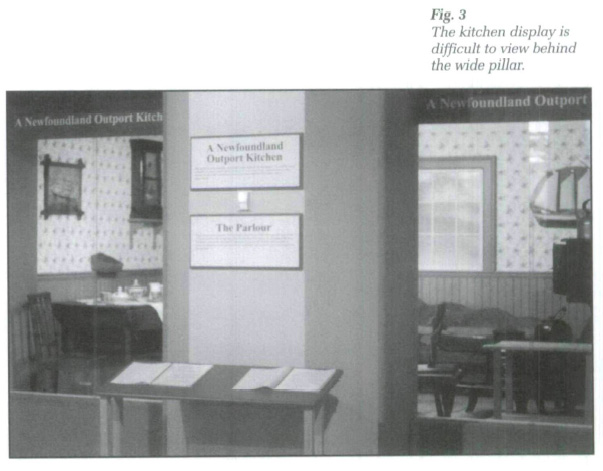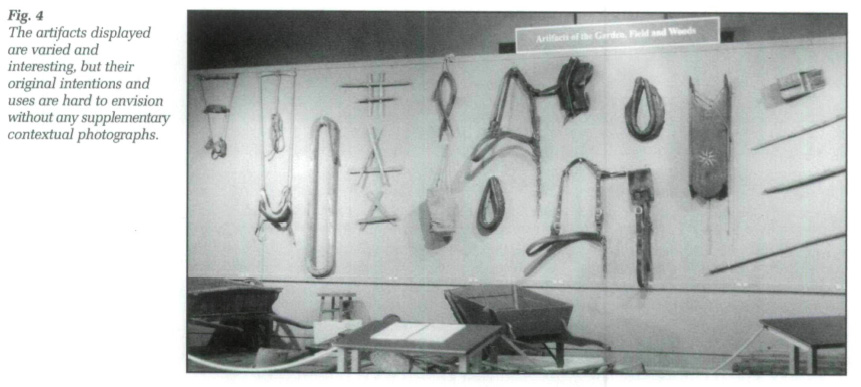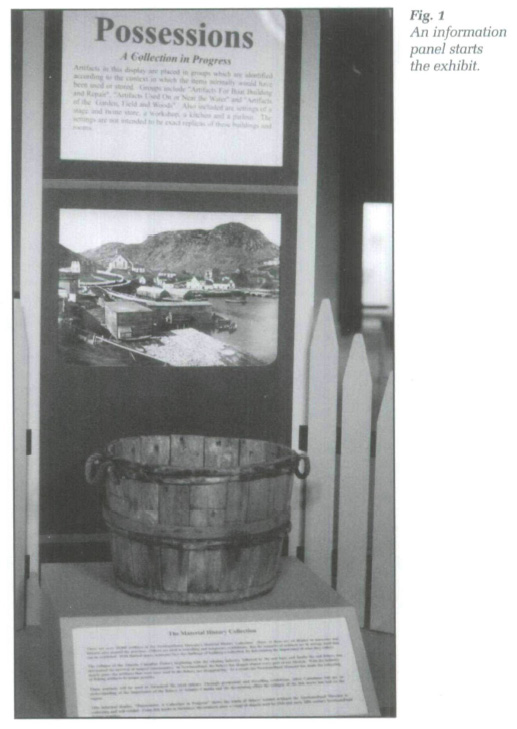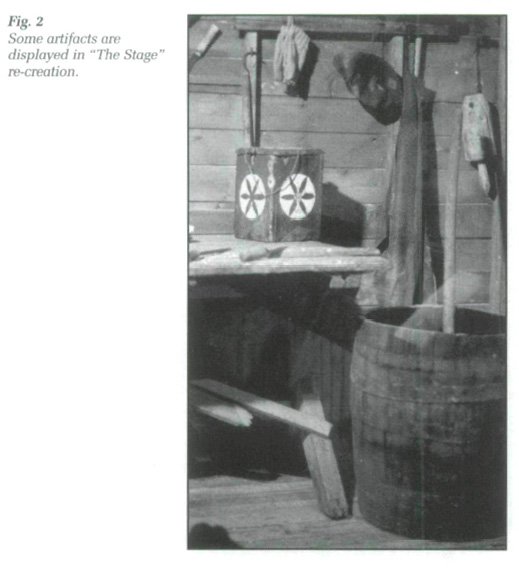Exhibit Reviews / Comptes rendus d'expositions
The Newfoundland Museum, St John's, Possessions: A Collection in Progress
1 The title Possessions: A Collection in Progress accurately reflects the essence of both the physical and visual components of an informal exhibit located on the third floor of the Newfoundland Museum on Duckworth Street, St John's, Newfoundland. The thematic focus of this exhibit, accordingly, centres around the everyday common possessions once owned, crafted, and used by Newfoundland fishing families during the nineteenth and early twentieth centuries. While there is no immediate reason offered as to why this particular era has been chosen to be displayed, I suspect there are a couple of explanations for its emergence at this time.
2 With the demise of Newfoundland's fishing industry and many of the associated traditional ways of life related to that industry, a variety of aged textiles and materials (including wood, fabrics and metals) have since fallen in danger of deterioration or eventual destruction. The exhibit provides a timely opportunity for the rescue, conservation and presentation of these vanishing older forms of fishery-related material culture. In essence, the exhibit is a material commemoration of the bygone era of the cod, whaling and sealing industries displayed through artifacts and contextual, partially re-created buildings and stage settings. Additionally, Possessions also coincided with the 1997 "John Cabot 500" celebrations and provided the influx of visitors and tourists to the province an opportunity to see a more familiar and less romanticized aspect of past life in Newfoundland.
3 The exhibit begins with an information panel explaining the grouping and presentation of the artifacts. Here we learn the objects in the exhibit are situated according to the context in which they were once used or stored, through displays of both indoor- and outdoor-type settings. Adjoining these panels of text, however, are an assortment of unexplained objects, including a wooden bucket or barrel of some sort, a short white picket fence, and a large photograph of an unidentified rural community (Fig. 1). Without any formal indication given as to the sequence in which the exhibit should be viewed, I have chosen to examine it in a counter-clockwise fashion.
4 The first display, consequently, is entitled "The Workshop." It consists of a simulated building in which the viewer peers through a series of windows to see various types of tools and materials one would have expected to find in such a setting. Although the workshop looks quite contextually realistic with its various artifacts having been carefully arranged inside,1 I find it quite difficult to identify the items. This is due to the absence of any classifying labels next to the artifacts, which might allow the objects to be matched up with the inventory-styled booklet found outside the windows. This is an unfortunate interpretive obstacle, as I am unfamiliar with such items as a "cartridge stuffer," "spoke shave," "large croze," or "dapper," and find it difficult to locate them. An additional problem here is that the accompanying inventory list does not elaborate on the historical significance of many of the artifacts. Only approximate dates and whether the artifacts were locally-produced, homemade, or imported are generally given.
5 Next along the exhibit is a display case containing artifacts for boat building, repair, and other related objects used on or near the water. The artifacts here are quite varied and interesting, with names such as "capstan," "tiller stick," and "whits," for instance, but again, they are not easy to identify in the display, nor given much interpretive narrative in the accompanying booklet. These objects are also arranged in a manner that make them appear to frame a large (and seemingly unrelated) photograph of a huge merchant ship in St John's harbour. A prominent, distinguishing geographic feature, Signal Hill, has been curiously smudged out in the background of the photograph.2
6 Adjacent to this exhibit is another re-created structure labeled "The Stage." Here we learn about its natural location near the water and its general usage for the gutting, cleaning, and salting offish, as well as being another storage area for certain commodities. There is almost a full page of information supplied in the inventory list concerning the importance and functions the stage served in its day. This is a well-presented room containing ample artifacts, but appears to be much tidier than it likely would have been in reality (Fig. 2).
7 Directly following "The Stage" setting appears to be an assemblage of structures and objects that might have existed around an actual stage edifice. The various objects displayed here include two wooden barrels, a large basket and wheelbarrow, four lobster traps, and a stage head. As there is no accompanying booklet or other textual information posted in the proximity of this display, the exact intentions and significance of these items remain open to persona] speculation and interpretation.
8 The next section of the exhibit consists of two displays depicting "The Parlour" and "A Newfoundland Outport Kitchen." There is slightly more written information available in this area concerning the contents, significance and social functions of these two rooms. To view the glass-encased kitchen, however, one must first semi-circumnavigate around an enormous upright beam, located directly in front of the display (Fig. 3). Some objects here still remain elusive, such as the "painted balsam fir whatnot"—its location and purpose is obscure. Why three women from Grand Bank, Newfoundland (without being given any further background introduction) have been extensively quoted in the accompanying booklets is also puzzling; I am left to assume they are, or were, residents of the region, who were possibly asked to comment on the objects and activities in such household spaces.
9 The final section of the exhibit is specified as "Artifacts of the Garden, Field and Woods." In this area, there are a variety of interesting objects spread out along the floor and walls, and the unobstructed view of these artifacts creates a refreshing and less voyeuristic feeling to the end of the exhibit (Fig. 4). With only fragmentary in formation available for how the "horse's hames" or "wood and metal harrow" functioned, perhaps the inclusion of some contextual photographs showing these objects in use would help to illuminate this display.
10 As Possessions is an "informal" version of a more elaborate travelling and perhaps permanent exhibit, there are consequently a few fundamental questions that need to be addressed after viewing the exhibit.
11 The first issue is whether or not the objects actually speak for themselves. I find myself thinking "no" in this particular case. While this great collection of "stuff" displayed as relics of the past is aesthetically pleasing and certainly sparks the imagination, I feel that a brief, accompanying interpretive commentary should not have been sacrificed. It leaves me feeling somewhat uninformed concerning how these objects played a part in Newfoundland's past. While the dates supplied for each item are somewhat helpful, at least a sentence of pertinent information explaining each object's traditional use and significance would also be both useful and informative. I feel I am misinterpreting exactly what many of the artifacts on display are, and how they might have once been employed. Perhaps what is missing is the option to read more about the objects.
12 Determining for whom this exhibit is intended remains unclear. Is it primarily for Newfoundland residents who might have once resided in, or had relatives from such rural communities?3 Is it also intended for out-of-province (or country) visitors who might be completely unfamiliar with past ways of life in Newfoundland? I am left with the impression that the exhibit would be appreciated mostly by select groups of people, such as object-specialists or those familiar with outport activities and their related objects. Such observers might not require further interpretation.
13 Another fundamental issue that must be considered is whether the exhibit succeeds in communicating its message effectively. Considering that Possessions: A Collection in Progress is still ongoing and by its title suggests it is essentially a collection of past possessions, I would have to offer a cautious "yes." The historical and cultural significance of the artifacts seem inferred by the elaborate re-created settings and dioramas. Additionally, as there is a focus on common objects once owned by fishing families (as opposed to elite-oriented commodities), it has intrinsically heightened the potential to reach and communicate to a larger number of people.
14 There are a few drawbacks in the exhibit, however, that reside in some of the design and technically-related aspects. Perhaps one of the more evident of these is how the inventory booklets have been firmly fastened onto knee-high tabletops, making them quite uninviting to read. Coupled with this is the minuscule font size of the lettering in the booklets which is difficult to read from such a distance. English-speaking visitors are at an advantage, as English is the only language used throughout Possessions. I was not able to locate any pamphlets containing other language translations of the accompanying inventories or even of the exhibit's synopsis. Ambiance is compromised by the location of a large stage and temporary seating area in the midst of the exhibit. This performance area seems to occupy at least one-third of the available floor space. Having such a designated area within the museum is laudable, but having the two media located in the same space is questionable.
 Display large image of Figure 3
Display large image of Figure 3 Display large image of Figure 4
Display large image of Figure 415 In summary, it is through the display of selected artifacts that the provincial museum presents an image of past culture in Newfoundland outports. While time and budgetary constraints play an important role in every museum exhibit, I believe that if a few thoughtful textual and design-oriented improvements were made in Possessions: A Collection in Progress, the result would be a more vibrant travelling or permanent exhibit. This would not necessarily involve a tremendous amount of money, nor the employment of a multimedia extravaganza as a solution to the problem. Although museum staff are, admittedly, at the mercy of a relatively small amount of government funding, the available money should be carefully utilized to enhance the effectiveness of provincial museum exhibits such as this one. Perhaps through the contribution of a multidisciplinary "team" to help create a more long-term vision for Possessions, the result might be a more satisfactory exhibit and less an overt "folk" cabinet of curiosities. Such a display would then better inform and educate those who are unfamiliar with the artifacts, and would also help to address the diverse levels of interest and intellect among museum visitors. Finally, I would recommend that this informal exhibit be viewed if one is interested in the display of genuine period-objects and aesthetically-pleasing room re-creations, but not for an in-depth, dynamic interpretation or dissemination of the artifacts.
Curatorial Statement
16 Possessions: A Collection in Progress was assembled in less than two months by a mere handful of Museum staff using existing props and a desktop printed storyline, and virtually no input from a designer.
17 Early in 1997, the History floor of the Newfoundland Museum on Duckworth St in St John's was in limbo. Most of the permanent displays had been removed from the floor in preparation for much needed renovation and the installation of new exhibits. Continuing harsh fiscal realities, however, had delayed this work indefinitely. Because 1997 was the year of the much publicized Cabot celebrations, St John's was expecting a larger than normal influx of tourists during the summer months. With very little time remaining and limited resources at its disposal, the Museum was facing a daunting challenge. It had to find something appropriate to put on the History floor as a contribution to the celebrations.
18 It was decided to assemble displays relating to the Newfoundland fishing culture. The writer already had developed concepts for both a permanent and a travelling exhibit on the subject. Furthermore, an initial storyline and artifact list for the travelling exhibit had already been prepared. The concept, storyline and artifact list could be adapted for the displays.
19 It was further decided to employ the appropriate context of the displays to inform visitors about current collecting activities and about the Museum's plans to produce new permanent and travelling exhibits.
20 To create the displays, artifacts were simply arranged in contextually related groups in selected locations on the floor, on walls and on several fixed exhibit props that had been left over from previous permanent exhibits. Several fixed structures located around the perimeter of the floor were employed to create realistic settings of a stage and twine store, a workshop, a kitchen and a parlour. Large printed headers were used to identify both the groups of artifacts and the settings and the adapted storyline was made available in booklets located in front of each setting and artifact group. Information relating to the material history collection generally, as well as the Museum's plans to produce new exhibits, was made available on several large panels, as well as in the booklets.
21 At this time of writing, Possessions: A Collection in Progress is still on display. It soon will be dismantled so that many of the artifacts contained in it can be re-employed in its travelling counterpart. Late in 1997, the Museum learned that its application for funding assistance from the Museum's Assistance Program, to produce its travelling exhibit, had been successful.
* A revised and expanded version of this exhibit, entitled Possessions: The Material World scheduled to open at the Newfoundland Museum in January 2000.

